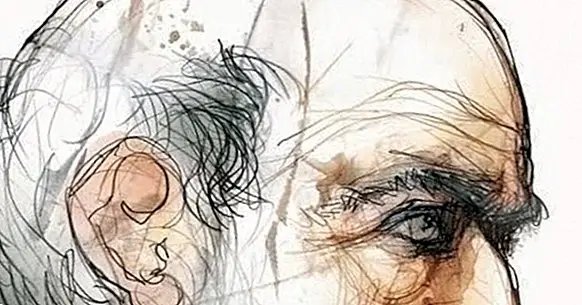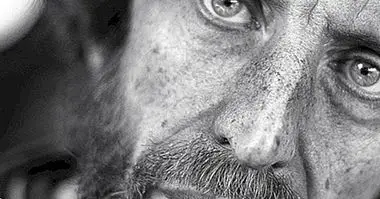The theory of the four humors, of Hippocrates
Psychology is one of the younger sciences, but that does not mean that it has not been developed over centuries, or even millennia.
In fact, some of the big questions he tries to answer started generating theories more than 2,000 years ago. The theory of the four humors, related to the different personality classes that we can find in human beings, is an example of that. It was proposed by the Greek Hippocrates.
The origins of the theory of the four humors
By the fifth century BC, Ancient Greece, which was the cradle of what would become Western civilization, was already beginning to forge theories about why we are the way we are and do what we do. Actually this kind of theoretical proposals had also appeared before in other areas of the planet, but the Greek case was of special importance because there the technical advances of Asia and Egypt were united with the philosophy and the powerful cultural and philosophical activity of the area.
Greece was a region in which knowledge was disseminated in a much freer way than, for example, in the Persian Empire, where the teaching of writing was very centralized and was basically used for trade and administration.
That explains that in just three centuries Ancient Greece could become a reference for the development of philosophy and science (a more embryonic phase). But Greek science, like what happened in other parts of the world, was mixed with religions and a vision of the world still based on old myths. That is what explains the emergence of the theory of the four humors .
What is the theory of the four humors?
Originally, the theory of the four humors, proposed for the first time by the Greek physician Hippocrates, was based on the assumption that the human body is composed of four basic substances (the so-called "humors") and that the equilibria and imbalances in the amounts of these substances in an organism determines the health of this.
These humors corresponded to the elements air, fire, earth and water , that some years before had been indicated by the philosopher Empedocles as the raw materials of everything that exists.
Thus, the theory of the four humors was not isolated from the way in which reality was understood in Ancient Greece, but it was connected with a belief about the origin of the planet and the cosmos in general; supposedly, all reality was a combination of different quantities of these four elements, and from there arose the theory of the four humors. The properties of these four elements, in turn, were reflected in the characteristics of the four humors that according to Hippocrates flowed through the human body.
The different humors according to Hippocrates
And what were these humors? Each of them expresses concrete physical characteristics, in the line of the thinkers of the time, who tried to describe reality from everyday properties and easily identifiable materially. Explained very above, were these:
1. Black bile
Substance linked to the element earth , whose properties were cold and dryness.
2. Yellow bile
Humor corresponding to the element of fire . His qualities were warmth and dryness.
3. Blood
The substance linked to the element of air , whose properties were warmth and humidity.
4. Phlegm
The substance related to water , whose properties are cold and humidity.
The moods and the personality
For Hipócrates and a good part of the doctors who assimilated the theories of the first one during the later centuries, the theory of the four humors offered a basis on which to work in medicine, no matter how precarious . Thus, many treatments for diseases consisted of modifying the diet of the patients so that, by ingesting certain foods, their humoral levels would be balanced. In some cases, bloodletting was performed so that patients lost fluid for the same purpose.
But this basis for medicine was not the only thing that emerged from the theory of the four humors. Some thinkers expanded it to be able to explain not only the health of people, but also the trends of their behavior and their mental life. Among these researchers Galen of Pergamum, a Roman physician and philosopher born in the second century AD. C .
The ideas of Galen

For Galen, the imbalances in the quantities of humors had an influence on the way we think, feel and act . Put another way, their proportions were the basis of people's temperament.In a natural way, each individual has levels of humors that very rarely are fully proportioned, and that is what explains personality differences.
When the black bile humor predominates, for example, he believed that the person tended to be melancholic and prone to sadness and the expression of intense emotions, while in individuals in whom there is a higher proportion of phlegm than the rest of the substances. Temperament would be characterized by its tendency to rational analysis of situations and its ability to remain calm.
The personality types were the following
As we have seen, according to this humoral view of the human being, health was found in the balance of these substances (the logic of the balances between fundamental elements was very frequent at the time). It was believed that some diseases or special situations could cause this disproportion to grow, aggravating the person's health and / or causing their temperament to become more extreme and discordant with respect to the way of being of others.
1. Blood
It corresponded to happy and optimistic people , with a tendency to express their affection for others and with confidence in themselves. It corresponded to the substance of the blood.
2. Melancholic
Temperament defined by the presence of a large amount of black bile, his associated temperament is sad, with artistic sensitivity and easy to move .
3. Phlegmatic
Corresponding to the phlegm humor, the people associated with this temperament would be cold and rational .
4. Choleric
Temperament related to yellow bile, it would express itself in passionate people, of easy anger and with great energy .
The theory of the four temperaments, today
The theory born with Empedocles and Hippocrates and expanded by Galen was one of the pillars of medicine until the Renaissance. Beyond this historical stage, however, it has served as an inspiration to some psychologists interested in the study of individual differences and personality, including Hans Eysenck.
You have to bear in mind that this classification system has no scientific value ; in any case, it can serve to inspire when developing theories and hypotheses that, with time, come to have empirical evidence in their favor.



















